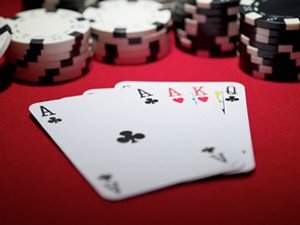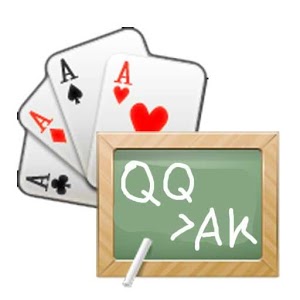Floating from out of position
Editor’s note: The following is from Jeff Hwang’s upcoming book, Pot-Limit Omaha Poker: Advanced Play.
Reverse float is the term I use for floating from out of position. The reverse float is far more risky than the basic positional float, because doing so from out of position sacrifices the benefit of the information gained from having your opponent check in front of you. As such, you need to have a much stronger initial read in order to execute the play from out of position.
Here are a few basic guidelines for floating from out of position:
1. If you float from out of position on the flop, you should tend to bet the full pot on the turn. Do so unless the board is paired or a flush is possible. If you bet less than the pot on the turn, you are setting yourself up to get refloated, even when you are right and your opponent is weak (recall the discussion on the resteal float from the last issue).
2. Unless you have some kind of draw or an outstanding read, you should tend to avoid floating from out of position against pot-sized bets on the flop. If you are facing a pot-sized bet and plan on betting the full pot on the turn, you are risking four bets to win two, in which case you have to win two out of three times. The problem is that not only don’t you get the benefit of seeing how your opponent reacts to the turn card, you also don’t get the benefit of him taking a weak stab on the flop – the high-percentage float indicator. The result is that in the absence of a very strong read, you may have very limited float equity when playing from out of position, which means that the value of the play is highly dependent on any draw you might have.
3. The three best spots for a reverse float are (1) against a possible weak stab on the flop, (2) when the board is paired on the flop, and (3) when the play is made on the turn, river rather than the flop, turn. These are the three spots where you get the best bang for the buck, because you don’t have to call a full pot-sized bet and then make a full pot-sized bet on the next street in order for the play to work. Moreover, weak stabs and paired boards yield higher-percentage floating opportunities to begin with.
Let’s take a look at a few examples:
Weak-Stab Reverse Float
The game: $1-$2 PLO (pot limit Omaha) online (six-max, deep), four-handed
My hand: Q 7
7
































Preflop: The under-the-gun player ($344.90) raises to $4. The button folds. The small blind ($266.65) calls. I ($397.90) call. (Pot: $12)
Flop: 9































I have bottom pair and the bottom end of an open-end straight draw (which really isn’t good), but I’ll take a shot against the weak continuation-bet, which signifies a weak hand or draw. I will bet a blank on the turn.
Turn: 2













Indicators: Continuation-bet/weak stab on the flop, blank on the turn.
Paired-Board Reverse Float
The game: $5-$5 PLO, five-handed
My hand: A


































Preflop: The under-the-gun player folds. The cutoff raises to $20. The button folds. I call. The big blind calls. (Pot: $60)
Flop: J
































Turn: 7







River: 2









I actually could have played this a few different ways: I could have check-raised on the flop, or I could have bet out on the turn; or, I could have played it as I did.
Indicators: Continuation-bet on the flop, check on the turn.
Turn, River Reverse Semibluff Float
The game: $5-$10 PLO
My hand: A














































Preflop: Five players limp in, the small blind limps in, and I check. (Pot: $70)
Flop: Q
































Turn: 7













I have a double-gutshot and a weak flush draw, which by itself adds up to a marginal call at best.
River: 3







The 3







Indicators: None on the turn, possible scare card on the river.
Reverse Bluff-Overcall Float
The game: $5-$10 PLO
My hand: 7












































Preflop: Two early-position players limp in. A middle-position player ($5,000) – a loose and frequent preflop raiser – raises to $60. Two players call behind him. The small blind folds. I ($3,200) call. The limpers call. (Pot: $365)
Flop: A
































Turn: 3













River: 2








This is a more complicated hand, in which it helps to know the players a bit.
After the flop got checked around, the preflop raiser took a stab on the turn; he probably would have bet A-A or A-5 on the flop. I also think the button would have bet those hands on the flop, and I think he knows that the preflop raiser would have bet the flop with those hands and is just calling to try to take the pot away on the river himself.
I actually do have four possible outs to full-house draws (two sevens, two sixes), plus the 4













The downside to being out of position is that I don’t get the benefit of having my opponents check on the river; the advantage to being out of position is that if my read is correct, I have first right to bluff on the river. I suppose that I just as easily could have bluff-raised on the squeeze on the turn, but in the event that I am wrong and happen to be facing quads, by calling, at least I have a chance to hit the straight flush.
Indicators: Check on the flop, weak stab on the turn.
This article was originally written by Jeff Hwang. Jeff Hwang is a semiprofessional player and author of Pot-Limit Omaha Poker: The Big Play Strategy. His latest book is Advanced Pot Limit Omaha Vol.1 and will be releasing Vol 2.
Submit your review | |










